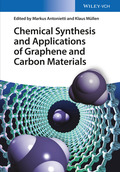Chemical Synthesis and Applications of Graphene and Carbon Materials

1. Auflage Januar 2017
XVI, 256 Seiten, Hardcover
140 Abbildungen (70 Farbabbildungen)
Handbuch/Nachschlagewerk
Kurzbeschreibung
This ready reference and handbook is unique in focusing on synthesis and the application of graphene and other carbon materials with an emphasis on chemistry aspects. It deals with top-down and bottom-up approaches, and presents the best synthetic methods.
Jetzt kaufen
Preis: 145,00 €
Preis inkl. MwSt, zzgl. Versand
Euro-Preise für Wiley-VCH- und Ernst & Sohn-Titel sind nur für Deutschland gültig. In EU-Ländern gilt die lokale Mehrwertsteuer. Portokosten werden berechnet.
- Gedruckte Ausgabe vergriffen -
This ready reference and handbook is unique in its focus on synthesis and the application of graphene and other carbon materials with an emphasis on chemistry aspects. To this extent, it deals with top-down and bottom-up approaches across the different length scales for graphene from polycyclic aromatic hydrocarbons to graphene nanoribbons and graphene sheets, as well as carbon materials from quantum dots, nanostructured particles, and fibers, right up to tubes, bulk structures, and much more besides. In so doing, it presents the best synthetic methods: pyrolysis, chemical vapor deposition, templating and surface-mediated synthesis, self-assembly, surface-grafting and modification.
Edited by two excellent, experienced and highly renowned editors, both of whom are directors of Max Planck Institutes.
Functional Carbon Materials from Ionic Liquid Precursors
The Chemical Synthesis of Graphene Nanoribbons
Functionalization of Graphene Oxide by Two-Step Alkylation
Towards Rationally Designed Graphene-Based Materials and Devices
The Fabrication, Properties and Uses of Graphene/Polymer Composites
Supramolecular Synthesis of Graphenic Mesogenic Materials
Synthesis and Characterization of Hexahapto-Chromium Complexes of Single-Walled Carbon Nanotubes
Hexahapto-Metal Complexes of Single-Walled Carbon Nanotubes
Functionalization of Graphene Oxide by Two-Step Alkylation
Novel Radiation-induced Properties of Graphene and Related Materials
Heterofullerenes: Doped Buckyballs
Graphene-Inorganic Composites as Electrode Materials for Lithium-Ion Batteries
Klaus Müllen joined the Max Planck Society in 1989 as one of the directors of the Max Planck Institute for Polymer Research. His broad research interests range from the development of new polymer-forming reactions to the chemistry of graphenes, dendrimers and biosynthetic hybrids. His work encompasses the formation of multi-dimensional polymers with complex shape-persistent architectures, nanocomposites, and molecular materials with liquid crystalline properties for electronic and optoelectronic devices. He owns about 60 patents and has published more than 1700 papers.


